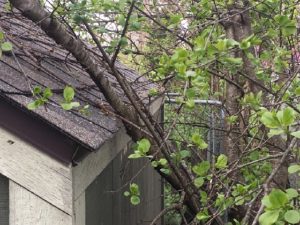Rain. When water
Wind. Strong winds can lift shingles or other roofing materials, forcing water or debris underneath them. Wind damaged shingles should be repaired immediately.
Sun. Heat and ultraviolet rays cause roofing materials to deteriorate over time. Deterioration occurs faster on the south and west facing sides.

Condensation. This is the result of the air temperature in the attic not being close enough to the exterior temperature. Condensation promotes rot and decay of the wood sheathing and the rafter system. Proper attic ventilation solves this problem.
Moss and Algae. Grows on moist shingles. The more the moss or algae grows the more moisture it will hold, keeping the roofs surface wet which, in turn, causes rot. Its roots work their way through the shingles and into 
Trees and Leaves. Branches rubbing and scratching will damage the roofing materials, shortening the roof’s life dramatically.
Remember, when it rains (or , especially during a snow or ice storm) tree branches will bend down more than they normally do. Trim appropriately. Leaves left on a roof retain moisture, rotting the surface.
We recommend gutter screens for all gutters.

NOTE: Old lead flashing should be replaced, over time it becomes porous and leaks. Not commonly found anymore.
Extremes in temperature and harsh weather conditions cause the tar to fail within a few years. Flashing should be checked every spring and fall for such deterioration.







